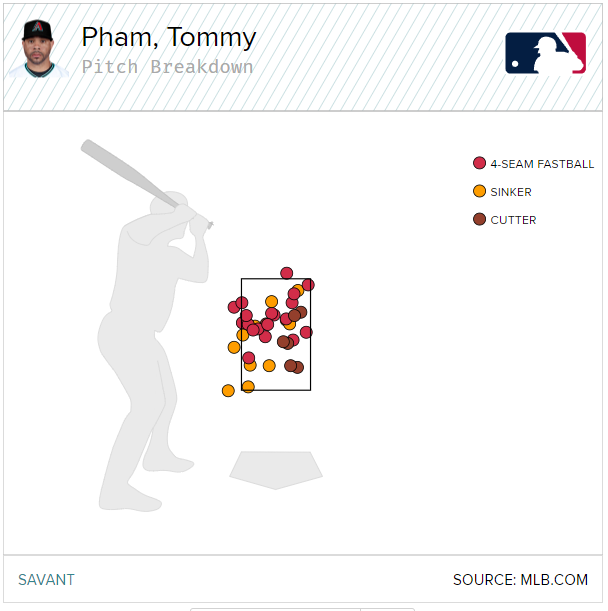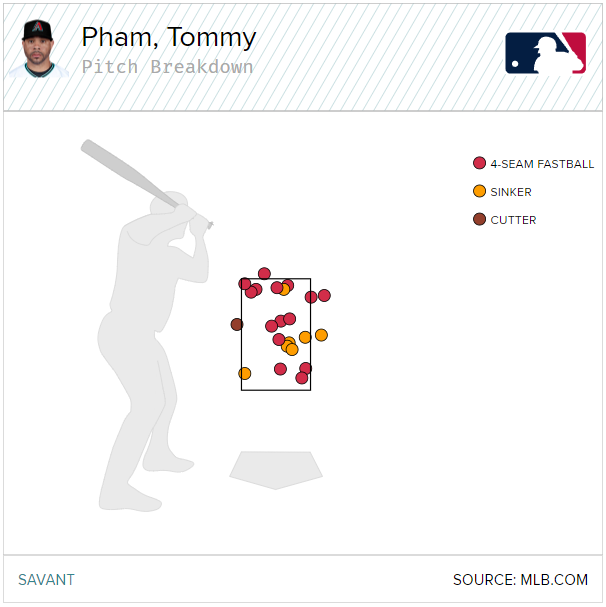How Tommy Pham Turned Things Around

Tommy Pham got benched this postseason. That probably sounds weird to you, and for good reason. He’s been one of Arizona’s most consistent players in the World Series, with hits in every game and a boatload of loud contact. But not so long ago – Game 5 of the NLCS, to be precise – Torey Lovullo sent Pham to the bench and didn’t even call on him to pinch-hit.
Why? It’s pretty simple: Pham wasn’t hitting. He struck out six times in his first 13 plate appearances of the championship series. More broadly, he was mired in a postseason-long funk. He was hitting .229/.250/.314 in October, and his peripherals were somehow even worse than that. He posted a 2.8% walk rate and 30.6% strikeout rate. His chase rate was up five percentage points compared to the regular season. His hard-hit rate was down, albeit in a tiny sample. Don’t write this off as merely a random blip; Pham was legitimately playing worse, and the poor results were a natural consequence.
While Torey Lovullo phrased it as more of a rest day – “I just was giving him a little bit of a blow,” he told Sam Blum – I think there was a little more to it than that. Zack Wheeler, the pitcher that night, has an expansive arsenal, but against righties, he tends to feature his sinker and sweeper. Sinkers might be Pham’s greatest weakness.
It’s no surprise that Pham struggles against grounder-inducing pitches. Take a look at his career numbers, and the reason is obvious: his swing is flat and level, ideal for hitting the ball where it’s pitched, which is evident based on his career 1.75 GB/FB ratio (league average this year was 1.13). He hits grounders on low pitches and fly balls on high pitches. Here’s how he’s done against both varieties of fastball in the past three years:
| Pitch Type | Chase% | Whiff/Swing | GB/FB | BACON | wOBACON | Hard Hit% | Barrel% | Run Value |
|---|---|---|---|---|---|---|---|---|
| Four-Seam | 11.5% | 18.6% | 1.13 | .386 | .452 | 61.4% | 15.5% | 15.7 |
| Sinker | 18.9% | 10.3% | 4.16 | .322 | .314 | 47.1% | 3.4% | -7.4 |
This is a pretty comprehensive look at it. Pham hits the ball harder, hits it in the air, hits for higher average, and displays more power against four-seamers. He even chases them less frequently. Throw him a sinker, and he’s mostly beating it into the ground and hoping for BABIP luck.
I assume that Pham is weak against sweepers for a similar reason. The data is so limited that I’m not going to read anything into it – he’s only put 18 sweepers into play in the last three years, at least partially because of changing pitch definitions – but they’re the kind of pitch that does really well against same-handed hitters, particularly contact-oriented ones who are likely to float some weak fly balls or pound them into the ground.
In any case, Pham didn’t face Wheeler at all, and when he returned to the lineup, everything changed. A simple way of looking at his turnaround: Before his day off, roughly 25% of his swings came against four-seamers, the pitch he handles best. Since then, he’s up to 33%, and he’s making those swings count. He’s also come up with a plan for sinkers. Here are the locations of all his swings against fastballs before Game 5 of the NLCS:

And since Game 5:

Instead of swinging at inside sinkers and getting jammed, he’s taking ones on the outside half of the plate and shooting them the other way. Righties hit .391 on opposite-field grounders in 2023; they hit .220 when they pulled the ball. If you’re going to put a sinker into play, you’d be well-served to go opposite field, particularly if, like Pham, you almost always hit it on the ground.
I’m leaving out one key element here: the pitchers Pham is facing. The vast majority of the swings in that first chart came against righties, while four of the seven swings against sinkers in the second chart came against lefties. The shape of those lefty sinkers is ideal for Pham’s plan; they tail away from his bat path, and since he’s thinking away already, that works out nicely. There’s a reason that sinkers display such a strong platoon split; it’s just physics and geometry.
Meanwhile, he’s also getting jammed less frequently on four-seamers and generally letting pitches on the inner third of the plate go. Before his day off, 40% of his swings against fastballs came on the inner third, and plenty of those were off the plate inside or otherwise hard to hit. Since his return, that number is down to 17%. It’s a tiny sample, of course, but you can see his plan at work. His power comes high and over the middle-away part of the plate, so he’s looking to that area more frequently.
At the end of the day, none of these changes are monumental. Pham didn’t suddenly become a new hitter overnight. His strengths and weaknesses remain roughly unchanged. He didn’t suddenly develop an uppercut swing to take advantage of the way he was being pitched. He changed a bunch of tendencies on the margins, and he got better matchups, and to be honest, he’s had good fortune on balls in play. All those little things add up. Suddenly, Pham is one of the hottest hitters on his team.
The next three games stack up well for Pham’s strengths. Nathan Eovaldi likes to live up in the zone with his four-seamer. Jordan Montgomery’s lefty sinker has already surrendered two opposite-field doubles. Jon Gray lives on four-seamers and gyro sliders. These are the kinds of pitchers Pham has historically feasted on, and the kind he’s hit well during his recent hot streak. Arizona needs all the help it can get to extend the World Series, and Pham looks well-equipped to be a part of that help.
Ben is a writer at FanGraphs. He can be found on Bluesky @benclemens.

Re “good fortune on balls in play,” he’s also playing with a toe injury and has been visibly faster running out ground balls the last few days. He’s looked considerably worse than usual in his limited outfield time during the postseason; the team’s recent care to get him off his feet by DHing and resting has seemingly paid off.